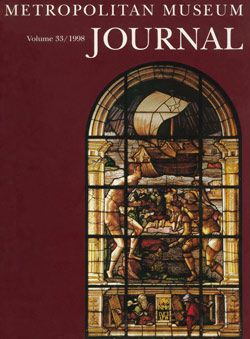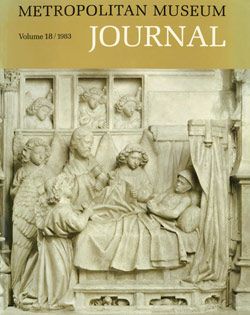Nose Ornament with Intertwined Serpents
Not on view
The Moche, who flourished on the North Coast of Peru from 200–850 A.D., created some of the most sophisticated metal body adornments ever discovered in the ancient Americas. This nose ornament, fashioned from hammered sheet, demonstrates the skill and ingenuity exercised by Moche artists. Two gold serpents with ears and fangs redolent of canines are seen in bilateral symmetry, joined by their intertwined bodies and a silver crescent-shaped plaque. Delicate gold danglers, attached with thin gold wires, hang from the sinuous bodies of the serpents and reflect light with the slightest motion, magnifying the sense of movement created by the fluid, curvilinear forms seen throughout the ornament.
This nose ornament is stylistically associated with a site called Loma Negra, where similar adornments have been unearthed from the several hundred shaft tombs in the area. Loma Negra, which is situated in the semi-desert region of the Piura Valley in northern Peru, contained a particularly rich collection of Moche metalworks in gold, silver, and copper. Regalia created from such precious materials were essential features of elite burials in the ancient Americas. This regalia, which included headdresses, earspools, nose ornaments, pectorals, and bracelets, were thought to identify the status of the interred in the afterlife. Nose ornaments, suspended from the nasal septum and often covering the mouth and lower face, were worn by high-ranking individuals in the Andes and were likely made to exemplify the power and position of the wearer both in life and in death.
The large quantity of funerary regalia discovered at Loma Negra suggests a strong relationship between individual and object in the Moche culture. According to Luis Jaime Castillo, body ornaments were often unique and personalized to each individual and could not be transferred to or inherited by others. Indeed, these objects may have been necessarily buried alongside their original possessors, for the link between ornament and owner was not to be broken even in death. In the underworld, adornments were even thought capable of transforming their wearers into supernatural or ancestral beings (Castillo 2017).
At the pinnacle of their power, the Moche elevated metalworking practices to new technological heights, increasing the number, size, and intricacy of metal objects. This nose ornament’s bimetallic composition bears testament to the metallurgical and mechanical achievements of Moche artists. The joining of gold and silver required expert knowledge of alloys, melting temperatures, welding techniques, and specialized construction methods (for detailed information, see technical analysis below).
The bimetallic arrangement also illustrates the Moche’s skillful incorporation of socio-cultural beliefs into their creations. In Andean cosmology, gold and silver were considered to be divine, animate materials. Gold was closely aligned with the sun and silver with the moon. Associated with these heavenly bodies that are at once conflicting and complementary, gold and silver further represented day and night, male and female, right and left. The union of these two metals may have thus, visually and metaphorically, symbolized harmony and balance.
Ji Mary Seo
Lifchez-Stronach Curatorial Intern, 2018
Technical Analysis
Studies by Deborah Schorsch, Objects Conservator at The Metropolitan Museum of Art, have revealed that this ornament was created from hammered sheet, like most Moche metal ornaments. Artists likely used chisels to cut the eye-shaped openings between the twisted bodies of the serpents. A series of tabs mechanically joins the gold and silver components of the ornament. These rectangular tabs, which extend from the top edges of the double serpents, are fitted on the front into slits cut along the bottom edge of the silver crescent and crimped closed on the reverse.
References
Benson, Elizabeth P. 2012. The Worlds of the Moche on the North Coast of Peru. Austin: University of Texas Press.
Bourget, Steve, and Kimberly Jones, eds. 2008. The Art and Archaeology of the Moche: An Ancient Andean Society of the Peruvian North Coast. Austin: University of Texas Press.
Castillo, Luis Jaime. 2017. “Masters of the Universe: Moche Artists and Their Patrons.” In Golden Kingdoms: Luxury Arts in the Ancient Americas, edited by Joanne Pillsbury, Timothy Potts, and Kim N. Richter, 25-31. Los Angeles: The J. Paul Getty Museum and The Getty Research Institute.
Fraresso, Carole. 2013. “The Sweat of the Sun and the Tears of the Moon: Gold and Silver in Ancient Peru.” In Peru: Kingdoms of the Sun and the Moon, edited by Victor Pimentel, 142-150. Montreal: Montreal Museum of Fine Arts.
Jones, Julie. 2001. “Innovation and Resplendence: Metalwork for Moche Lords.” In Studies in the History of Art, Volume 63: Moche Art and Archeology in Ancient Peru, edited by Joanne Pillsbury, 206-221. Washington, D.C.: The National Gallery of Art.
Jones, Julie. 1979. “Mochica Works of Art in Metal: A Review.” In Pre-Columbian Metallurgy of South America, edited by Elizabeth P. Benson, 53-104. Washington, DC: Dumbarton Oaks Research Library and Collection.
Lechtman, Heather, Antonieta Erling, and Edward J. Barry Jr. 1982. “New Perspectives on Moche Metallurgy; Techniques of Gilding Copper at Loma Negra, Northern Peru.” American Antiquity 47: 3-30. https://doi.org/10.2307/280051.
Maldonado, Blanca E. 2017. “For Gods and Rulers: Metalworking in the Ancient Americas.” In Golden Kingdoms: Luxury Arts in the Ancient Americas, edited by Joanne Pillsbury, Timothy Potts, and Kim N. Richter, 15-23. Los Angeles: The J. Paul Getty Museum and The Getty Research Institute.
Pillsbury, Joanne, Timothy Potts, and Kim N. Richter, eds. 2017. Golden Kingdoms: Luxury Arts in the Ancient Americas. Los Angeles: The J. Paul Getty Museum and The Getty Research Institute. Cat. no. 20, p. 145.
Schorsch, Deborah. 1998. “Silver-and-Gold Moche Artifacts from Loma Negra, Peru.” The Metropolitan Museum of Art Journal 33: 109-136.
#2206. The Art of Dress: Nose Ornament with Intertwined Serpents, Part 1
-
2206. The Art of Dress: Nose Ornament with Intertwined Serpents, Part 1
-
2225. The Art of Dress: Nose Ornament with Intertwined Serpents, Part 2
Playlist
Due to rights restrictions, this image cannot be enlarged, viewed at full screen, or downloaded.
This artwork is meant to be viewed from right to left. Scroll left to view more.







